An aircraft carrier is a moving airbase that can house approximately hundred combat aircraft. Being a ship, it can also sail to its war theatre quickly. By remaining in international waters, it can launch punitive airstrikes on enemy targets. A combat aircraft can drop two tons of bombs in one go. So, hypothetically, 100 aircraft from a carrier can drop 200 tons of bombs on the enemy’s head, at a time.
A century ago, after the invention and eventual militarisation of the aircraft, somebody from the navy thought, “Why do we not operate aircraft from larger ships?” This idea led to the construction of a cantilever on a ship, from which the aircraft took off and landed on.
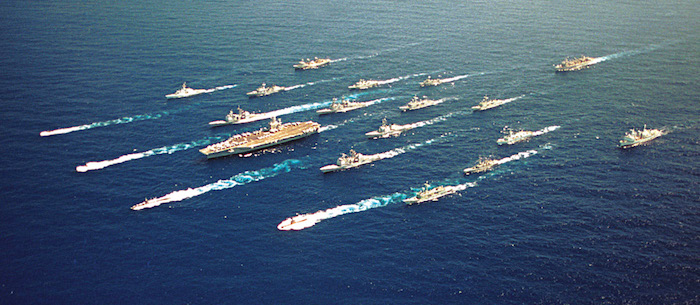
This resulted in the construction of dedicated aircraft-operating ships, which were called aircraft carriers or, simply, carriers. But these were not taken seriously, initially, and were used only as escorts or scouts to battleships, because during that era, combat aircraft itself was not considered an effective weapon altogether.
This perception changed during World War II as Luftwaffe (German Air Force) taught damaging lessons to allied nations about the combat prowess of aircraft.
From the other side of the globe, Japan delivered a devastating aerial strike at Pearl Harbour using their carrier based aircrafts. In one stroke, they almost entirely decimated the Pacific fleet of the US Navy (USN) but missed to destroy US navy’s carriers.
USN, after losing powerful battleships, had to retort to aircraft carriers as primary fighting weapons. It urgently assembled various ships to form taskforces with carriers as centrepieces and other ships to protect the carriers. These taskforces proved their mettle in the subsequent Battle of Midway and numbed the supremacy of Imperial Japanese Navy (IJN) in the Pacific. From that instant, aircraft carriers took the driving seat in naval warfare.
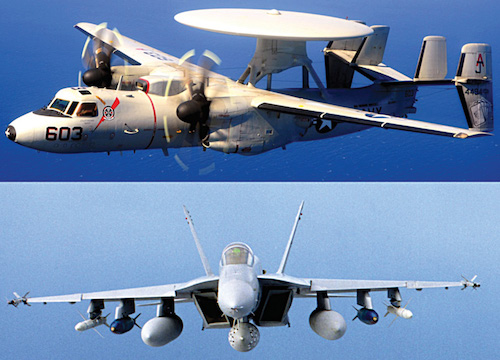
Years after World War II, these taskforces morphed into formidable naval forces called carrier strike groups (CSGs). CSGs pack enormous strike power but, at the same time, come with a sky-high bill. For CSGs to survive and unleash their power, various electronic systems serve as the backbone. The electronic systems present in USN’s CSGs and how these play crucial roles are the subject of foci in this mil-tech article.
Defensive combat operations
The purpose of a CSG is power projection; in simple words, launching combat aircrafts from the carrier stationed at deep seas and bombing the enemy. But the carrier being a highly-praised and priced target, objective of the enemy is to first destroy the carrier when the war begins. This could even turn the tide of the war.
Being a gigantic sitting duck on the sea, the enemy can easily find the carrier and attack either using aircraft, surface ships or submarines. So, in order to protect the carrier, a CSG typically comprises four to six destroyers (a kind of warship), two cruisers (a larger warship) and a nuclear attack submarine.
Destroyers are highly specialised in defending the carrier from threats posed by enemy surface ships and submarines. These also have respectable capability against aircrafts.
Cruisers, which are slightly larger than destroyers, are specialised in taking care of enemy air threats. Due to a larger size, these possess more weapon capability than destroyers. While destroyers operate at around 40km from the carrier to form a defensive perimeter against surface and sub-surface threats, cruisers operate in the vicinity of the carrier to provide air defence.
The two complement each other. Through a myriad of sensors, these can detect and neutralise the threats arising from all directions. Nuclear submarines sail well-ahead of the carriers looking for enemy submarines and operate loosely bound to the carrier. All these vessels try to form an impenetrable virtual bubble around the carrier.
A CSG wages offensive air strike battles (strike warfare) on the enemy and, at the same time, wages defensive battles against enemy aircrafts, enemy submarines and enemy surface vessels.
Air defence warfare
During World War II, in Battle of Midway, a group of aircrafts from the USN came directly above IJN carriers Soryu, Kaga and Akagi, and bombed these. This was the turning point of War at Pacific and even of World War II. Losing these carriers in just minutes proved too crippling for Japan, which ultimately put an end to Japanese Empire’s naval supremacy in the Pacific in the days that followed. This ultimately led to the defeat of the Empire of Japan itself.
In hindsight, the radar’s absence in Japanese carriers was the key. Ship-borne radars were yet to be introduced in these carriers. So, American aircrafts were able to bomb Japanese carriers undetected. But American carriers had been fitted with ship-borne radars, using which these could detect Japanese aircrafts beforehand and launch their aircrafts to defend in the nick of time.
Now, desperate Japan was looking to neutralise American carriers. To do so, some Japanese pilots rammed their aircrafts, fully-loaded with bombs and fuel, into American carriers, in what is called Kamikaze Attack. All these modes of attacks served as lessons for USN. When it started its ambitious carrier building and operating programme, air defence was given utmost priority.
Further to cement the importance of air defence, the USSR (of which the present Soviet Union was a part) entered into the picture as the newfound adversary of the USA to fight Cold War, a war fought without pulling a shot. The USSR sensed the challenging supremacy of the American carriers and fielded the deadly adversary of the carriers, the cruise missiles.
Having been developed inspired by Kamikaze aircrafts, cruise missiles offered a convenient means to attack a carrier. Earlier cruise missiles were just unmanned Kamikaze aircrafts.
From the cost perspective, a cruise missile costs a fraction of a carrier. But it is a very viable weapon, capable of being launched from bomber aircraft, warships and submarines. Incidentally, many of the early Soviet cruise missiles had nuclear warheads, sufficient enough to melt the entire steel present in the CSG.
The Soviet scheme was to simultaneously launch these missiles from submarines and bombers against the carrier from very long distances. Navigation computers of these missiles were programmed in such a way that all cruise missiles reached the carrier at the same time but from different directions. This was called the saturation cruise missile strike plan of the Soviet. Even if one cruise missile would hit the target, that would have been sufficient. This changed the situation in favour of the USSR.
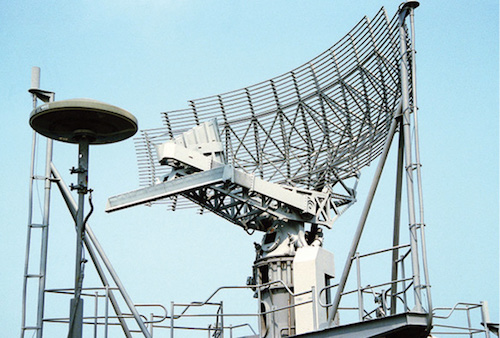
Air defence warfare capabilities of the CSG have been on constant updates and upgrades all these years. Today, air defence systems of an American CSG can be termed as the most superior system in the world. Protecting the CSG from cruise missiles and cruise-missile-launching aircraft is called air defence warfare.
Air defence operations are carried out in four phases.
Phase I: Fighter aircraft and AEW aircraft combo
The first line of defence of the CSG is carrier-borne F-18 combat aircraft, which can operate far away from the carrier and shoot down enemy bombers before they launch cruise missiles. But these cannot find bombers quickly, because they do not know their exact location.
Onboard radars of F-18 aircraft can accurately scan specific sectors and specific altitudes but not all sectors and altitudes. To guide these towards incoming bombers, a dedicated airborne early warning (AEW) aircraft (also carrier-borne) is used.
These AEW aircraft, named E2, have huge radars. An inverted saucer-like structure on the top is the radome for the radar antenna. Radome is a structure made of radio-transparent material to protect the radar antenna from the environment. Inside this radome is the rotating antenna of the high-power UHF Doppler radar.
This radar can detect and track multiple threats on the sea and in the air. It can simultaneously and automatically detect and track 2000 targets, spread across the air and sea.
The aircraft keeps tab on an area of over twelve million cubic kilometres (three million cubic miles). Not only that, it can precisely track cruise missiles that fly low enough, as if skimming the water surface. Being a crucial component for the defence of the carrier, this radar is highly capable of resisting the jamming efforts of the enemy.
These aircraft maintain a surveillance patrol far away from the carrier and act as a command-and-control (C2) station. These see what the radars of the CSG cannot see. If AEW aircraft detect any enemy bombers at a long range, these communicate the same to the carrier through a data link. Immediately, F-18 combat aircraft from the carrier are scrambled. These take off and race towards incoming enemy bombers to intercept and stop these from launching deadly cruise missiles. When F-18 aircraft reach their area of responsibility, AEW aircraft vector these towards the threat. F-18s intercept and shoot down bombers. There are four such AEW aircraft on a carrier.
Phase II: Air search radars and fighter aircraft combo
Air defence operations relying on this combination is a grave scenario. It occurs when the AEW aircraft itself has been shot down. This scenario is very much possible if the incoming enemy aircraft force is large. In this case, CSG radars are the only means to detect enemy air targets. For this, the carrier has two air surveillance radars: a 2D radar and a 3D radar.
2D air-search radar. A 2D radar gives the two dimensions of the target’s position: range and bearing of the target. 2D radar AN/SPS-49 operates in L band (851MHz–942MHz) and can detect air targets at a range of 463km (250 nautical-miles).
It can scan up to an altitude of 46km. A two-cavity Klystron oscillator is behind its peak power of around 350kW. Due to the thinness of the beam produced, it becomes difficult for the enemy to jam it.
Its antenna rotates at 6rpm to detect flying objects at longer ranges. The flying object’s position is updated every ten seconds. When that flying object approaches further, the antenna rotates at 12rpm. Now, the flying object’s position gets updated every five seconds, which results in the target being tracked continuously.
This radar can simultaneously track 255 targets. Since it is sitting on the ship, it is subjected to the pitch and roll of the ship. To overcome this, the antenna is gyro-stabilised. And because of this, even if the ship rolls to the side or pitches up or down due to the waves, this antenna stays where it was before the roll or pitch.
Through identify friend or foe (IFF) components organic to the radar, the targets’ friendliness is determined.
IFF shoots an ultra-short pulse-coded narrow beam of radar energy to the flying objects as a challenge. The friendly aircraft through an IFF receiver receives this and responds with a suitable reply. The radar receives this reply and classifies the flying objects as friendly aircraft. Now for the radar’s IFF challenge, if there is no proper reply from an aircraft, it is assumed to be a hostile aircraft, and its course is continuously tracked. All air-surveillance radars of the CSG have IFF.
3D air-surveillance radar. If a target of interest appears, 3D radar AN/SPS-48 takes over. A 3D radar provides the range and bearing like the 2D radar but also provides the height of the target, which is an extra dimension of the target’s position.
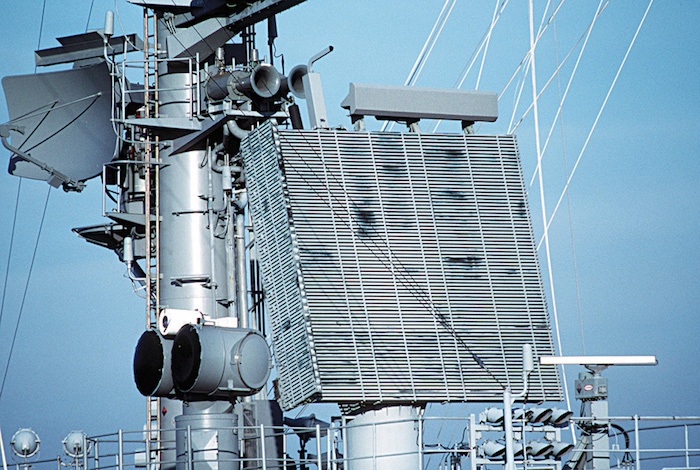
Normally, to find the height of the target, a separate radar known as a height-finding radar (HFR) is used with the 2D radar. HFR’s antenna always nods up and down to direct the beams to find the height of the target.
But 3D radar is a computer-controlled planar-array radar that varies its frequency instead of nodding the antenna up and down. By changing the frequency of the transmitted RF energy, this radar radiates a series of pencil beams. If the transmitted frequency is increased, the beam travels down the face of the antenna, and vice versa. The radar computer keeps track of the frequencies as these are transmitted and detects when the target reflects these. Further, it converts returned frequencies into meaningful altitude data. For finding the range and bearing, it simply rotates the antenna like a 2D radar.
Operating in the range of 2900MHz to 3100.5MHz (S band), a 3D radar can detect targets up to a range of 407km (220 nautical-miles) and heights up to 30km. It emits radar energy with a peak power of 2.2MW and an average power of 35kW. It has automatic detection and tracking capabilities to simultaneously detect and track multiple air targets. It also has a moving target indicating (MTI) capability, which helps distinguish between moving targets from stationary targets. Hills or a landmass produce radar echoes, which is landmass clutter. In the radar-signal-processing circuitry, echoes from stationary features are attenuated. The resultant echo is of the moving targets.
Radar AN/SPS-48 is electronically-stabilised instead of gyro-stabilised. To compensate for the pitch and roll of the ship, the frequency emitted is changed to compensate it. This is similar to the height-finding technique.
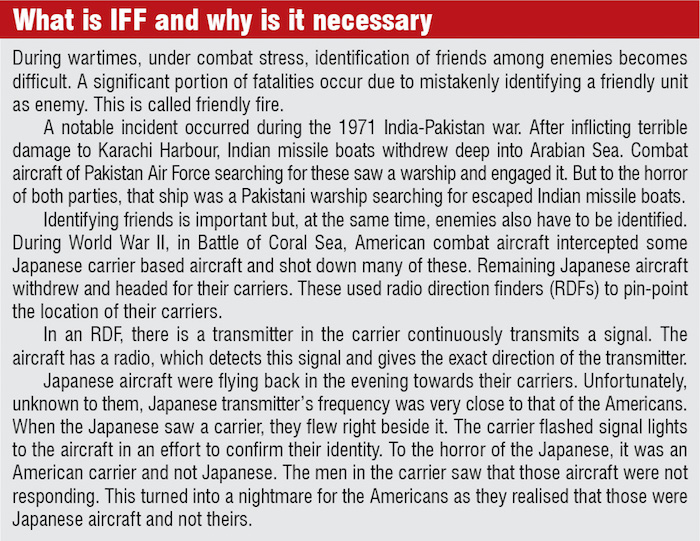
Using this tracking data, fighter aircraft can be scrambled towards incoming threat to intercept it. The carrier constantly updates the aircraft with the target’s location until interception, through datalinks.
However, if the enemy aircraft has launched its cruise missiles, the cruise missiles become the target. Engaging the cruise missile through the fighter aircraft becomes difficult. So, air defence warfare progresses to Phase III and is carried out through surface-to-air missiles (SAMs) of the CSG.
Phase III and phase IV of air defence operations will be covered in next part of this article.






